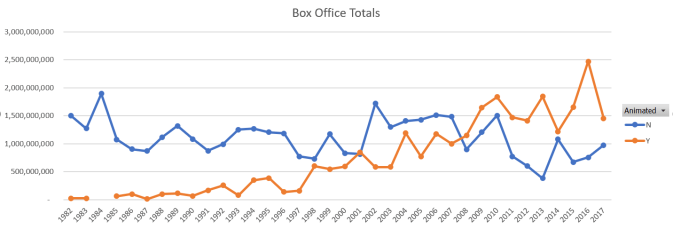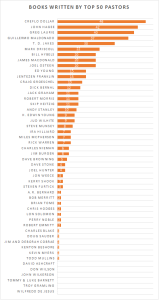Were the 90’s really the mecca for live action kids movies? And how much more profitable are animated movies these days?

Note: The PG-13 rating did not exist until half-way through 1984.

Curious what caused those huge 2016 numbers? Finding Dory, Zootopia, and Moana.
I haven’t written a post in a while because I tried creating this database of all high school mascots and that got a bit too tedious, had to find too many manually. Still working on it, hope to finish someday.
I was thinking back to what movies I really enjoyed in my childhood in the 90’s. The Sandlot, Mighty Ducks, Casper, The Big Green, Blank Check, Andre, A League of their Own, The Rookie, Now and Then, Matilda, Home Alone, Heavyweights, Toy Story, Camp Nowhere, Free Willy. The list goes on and on. Notice that they’re all live action, except for Toy Story? The 80’s and 90’s had a ton of good live-action kids movies. Nowadays, it seems like there are way more animated movies and a lot less Mighty Ducks. Were the mid-90’s really the mecca of live action kid movies? I set out to find out if this is really true.
At first, I started combing the internet manually, putting together lists of kids movies per decade. I also wrote SPARQL, the query language for wikipedia, to pull down movies with the genre “children’s film”. I looked at trailers and synopses to determine if a movie could be branded a kid’s movie if it wasn’t obvious to me. There were some tough dilemmas, like Now & Then is rated PG-13 but as an 11-year-old, I loved it and it featured kids around my age. Is that a kids movie? I think so, but the rating disagrees. What about PG romantic comedies, like Sleepless in Seattle? In the end, this proved too cumbersome, especially considering there are way too many movies in the 1980s and 2000s that I was not familiar with, so I started all over. I resorted to simply copying down lists of movies from the site boxofficemojo. You can get lists per year and rating, so I took down all the G and PG-rated movies for each year, 1982-2017 (1982 was the earliest year using the aforementioned filters). I then marked which ones were animated, which took a bit of time, but at least it was an unambiguous task, I thought, until I ran into movies like Space Jam, Hop, and the Muppet movies. I decided to label those live action. Of course, I wouldn’t call all PG movies “kids movies”- there are definitely a lot from the 80s that looked like adult movies to me- but I figure this is good enough criteria to answer my research question without spending a million hours.
The first graph shows simply the number of movies rated G or PG per year, broken up by animated or live action.* The second shows their box office numbers. As you can see, animated movies are becoming more common and raking in a ton of money for movie studios, while live-action G/PG movies are on the decline. There were 67 live action G/PG movies 1984 and it has slipped a lot since then, with only nine being released in all of 2013! One thing to consider is that the PG-13 rating did not exist until part way through 1984 and something that was G back then wouldn’t necessarily be G now. The fact that you see a sharp drop off in PG movies after 1984 can attributed partly to this. There was a bit of a peak in the mid 90’s, during the height of my childhood (I was born in 1986), like I suspected. I grew up on live-action movies and to this day, don’t care as much for animated movies, but I know that’s not true for everyone my age.






